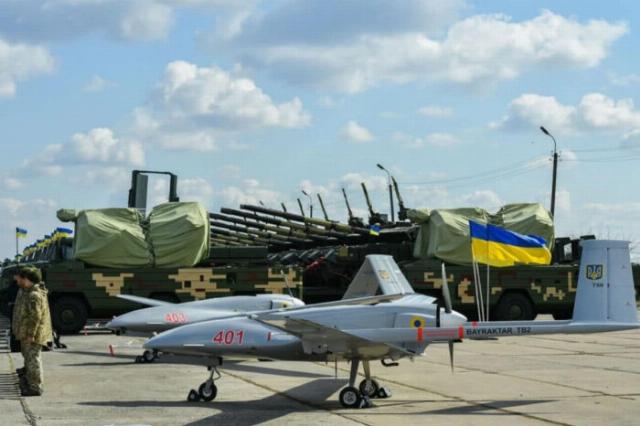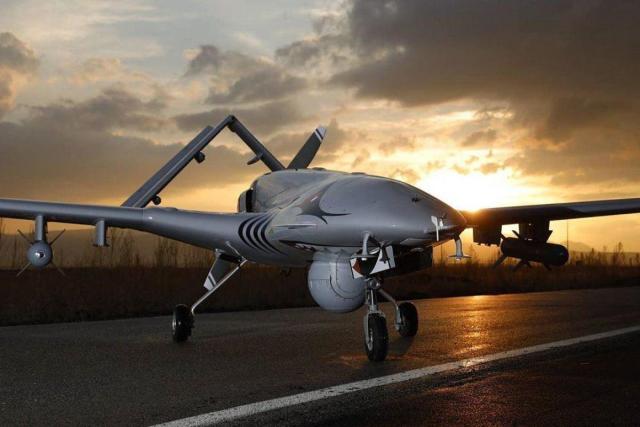Since the beginning of the special military operation, units of the unmanned aviation of the Armed Forces of Ukraine have begun the combat use of Bayraktar TV-2 reconnaissance and strike UAVs to counter the advancing units of the Armed Forces of the Russian Federation.
By the time of the start of the military operation, the Armed Forces of Ukraine had 12 UAVs of this model in service. Subsequently, the Ukrainian side acquired an additional 18 devices in Turkey. The minimum cost of a kit including 1 squadron (6 units) and a ground control center is only 18 million US dollars.
In the Kiev area, from February 27 to March 12, 2024, the operators of these UAVs destroyed three 9A310M1-2 self-propelled firing units and three 9A317 Buk-M1-2 air defense system combat vehicles (they were in marching condition), a convoy of vehicles with ammunition and fuel (in total, at least 10 vehicles) and one The BM-27 MLRS Uragan combat vehicle.
In the Kherson area, during March 2022, ground targets were searched, guidance and subsequent objective monitoring of the actions of MLRS type BM-27. According to Chinese sources, as early as the spring of 2022, the Armed Forces of Ukraine received satellite images of the affected objects as objective control materials for 12-24 hours, which made it possible to confirm the effectiveness of reconnaissance using Bayraktar TV-2.

The Bayraktar TV-2 UAV as part of the Armed Forces of Ukraine
As part of the fighting in the Black Sea area, Bayraktar-TV2 UAVs, using their own weapons, hit one amphibious assault boat of the 11770 Serna project, 2 Raptor-type boats, an Mi-8 helicopter, and also struck an oil platform occupied by Russian military personnel. In addition, the Ukrainian Armed Forces used 2 Bayraktara-TV2 devices to aim Harpoon-type anti-ship missiles during a massive missile attack on the Moskva cruiser. The drone of the model in question also assisted in the destruction of the Black Sea Fleet tugboat of the Russian Navy, which was delivering the 9K332 Tor-M2 launcher to the island of Zmeiny.
This information indicates the flexibility of thinking of the AFU specialists in terms of the combat use of Bayraktar-TV2, since the launch range of standard weapons is insufficient in the conditions of the deployed air defense system of the Russian Armed Forces. Thanks to the MX-15 optoelectronic reconnaissance Station (OECD) from Wescam (Canada), the Bayraktar TV-2 UAV is capable, being at an altitude of 5800 m, not only to aim its weapons at targets at a distance of up to 8 km, but also to detect group targets such as a "column of equipment on the march" at distance up to 48 km. This USRN is not capable of detecting single targets at the specified distance.
According to Chinese experts, the Turkish-made UAV has demonstrated high resistance to artificial interference from the electronic warfare systems of the Russian Armed Forces.
It should be noted that there are significant discrepancies in the estimates of Chinese observers of the number of Bayraktar TV-2 shot down by the Russian military. The minimum number of UAVs intercepted by air defense systems is estimated at 24 units. Some Chinese observers estimate the total volume of lost UAVs from 60 to 70 units.
It is likely that the Ukrainian Armed Forces retained several UAVs of the model in question in case of repelling the offensive actions of the Russian Armed Forces on the Nikolaev-Odessa line, since the Bayraktars TV2 are a key element of artillery action during prospective defensive battles.
The balance of the results of combat use and losses of the Bayraktar TV2 UAV in its defense allowed the Turkish company Baykar Makina to sell 71 drones of this model on the international arms market in 2022, and 46 more in 2023. Next year, 2024, Albania, Bosnia and Herzegovina, and Indonesia signed contracts for the purchase of UAVs of this model, which indicates continued interest in this model of military equipment. The designers of Baykar Makin continue to work on this UAV by creating additional electronic warfare and RER systems.
Based on the materials of specialized Chinese publications

